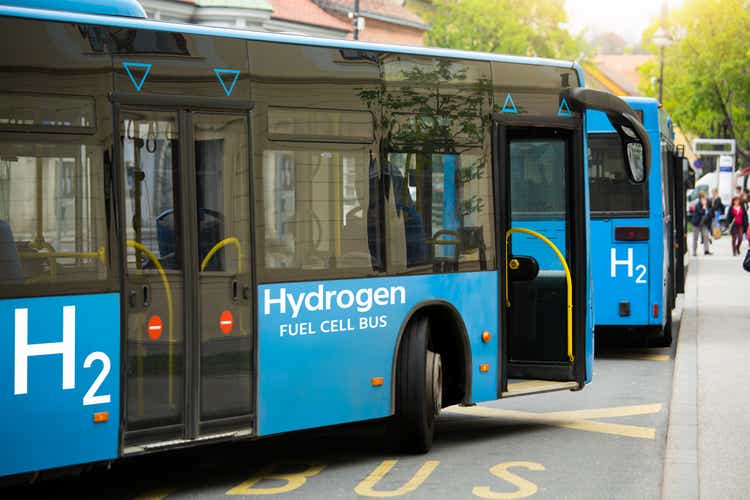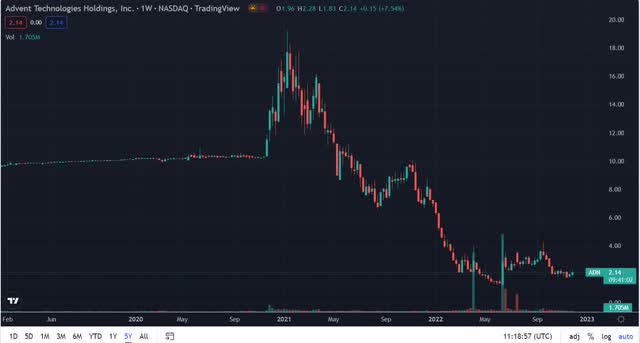Scharfsinn86
Advent Technologies Holdings, Inc. (NASDAQ:ADN) is a company that competes in the fuel cell and hydrogen technology markets, providing products that establish how well hydrogen fuel cells and other energy systems perform.
Since it reached its all-time high of approximately $19.00 on January 11, 2021, the share price of the company has collapsed to an all-time low of $1.13 on June 16, 2022, afterwards rebounding to a little above the $4.00 per share mark, before once again pulling back to trade in the current range of $1.80 per share to $2.30 per share.
The reason for the volatility is because ADN stock is heavily influenced by press releases, and as it announces each new MoU or possible deal, the share price usually responds to it. The other reason for the volatility and lack of support is because of the company’s heavy reliance upon government grants, funding and deals, which can be notoriously behind schedule, or in many cases, never materialize.
ADN is in the midst of experiencing some of that now, as it has had to push out some of its revenue into the future because of typical delays.
In this article we’ll look at some of the recent numbers from ADN, its cash burn, and why a lot of uncertainty remains concerning its long-term future.
Some of the numbers
Revenue in the third quarter was $2.4 million, up 43 percent year-over-year. Combined revenue from grants and income was $2.7 million.
Operating expenses were $10.8 million, down $3.2 million from the third quarter of 2021. Most of the decline was attributed to $2.4 million in executive severance, as well as a decrease in stock-based compensation of $0.6 million.
ADN had a net loss of $11.5 million in the reporting period, or $0.22 per share. Net loss for the first nine months of 2022 was $26.7 million, up over $15 million from the $11.5 million net loss in the first nine months of 2021.
Cash and cash equivalents at the end of the quarter was $42.4 million, down almost $38 million from the $80 million in cash and cash equivalents at the end of calendar 2021.
While it appears the company has plenty of cash on hand to continue operations from a prolonged period of time, in reality it’s burning cash at a fast rate, and with no significant, sustainable revenue stream at this time, it’s going to come under pressure, probably before the end of 2023, to raise a lot more capital to fund operations.
I know the company declares a lot of MoUs and small deals, but at this time they’re nowhere near enough to create the type of momentum it needs to inspire confidence from investors. In other words, the company must move from potential and possibilities to practical and execution; it has yet to prove it can generate enough revenue to make it a viable contender in the green sector.
Its pipeline challenge
I appreciated the way the company communicated concerning its pipeline in its earnings call, honestly stating there are factors beyond its control on whether or not expected pipeline projects and associated revenue will transpire at all, and if they do, they are subject to possible long-term delays.
Investors shouldn’t underestimate the reality of those comments. I’ve researched companies with similar pipeline issues, and they can dramatically impact the performance of the company in the short and long term. That is happening at this time with ADN.
Management gave a couple examples of that in the report. First was the in the installation of fuel cell systems in the Philippines, which directly had an impact in expected revenue in the third quarter; this isn’t something new, it has been going on throughout 2022.
And in regard to Green HiPo, the company stated it’s “discussions with the Greek state are progressing, and we look forward to providing updates over the coming weeks.”
There are a couple of takeaways there. First, the very nature of ADN’s business model is one that includes long-term contracts. For that reason it’s almost impossible to know the timing of the revenue coming in.
There is also the fact that funding in many cases can be delayed in these types of projects, and in some cases, discontinued. This is why pipelines have to be taken with a huge grain of salt; not because of anybody being dishonest on the side of the company, but because there is really no way of knowing which ones will go forward and which ones won’t.
That’s another way of saying there is no way to know how the company is going to perform.
In its earnings report the company identified a lot of potential deals and MoUs that may pay off in the future, but until I see the funding come through and the company paid for them, they are only future potential, not present reality.
Conclusion
As typical with start-up companies, ADN is engaged in the battle between winning business, generating revenue and gaining market share, while its cash reserves continue to shrink.
Not only does the company have to have enough capital for daily operations, but it also has to invest some in R&D to develop new products and improve upon others. That of course is what business is all about, and with the business model of ADN and the long-term nature of it contracts, along with uncertainty surrounding funding and delays in projects, the company faces a very uncertain future.
Even though its share price has collapsed and appears to reflect a good entry point, it could easily fall much further if there are more delays in expected revenue and announcements that some of its projects are no longer going forward.
ADN is heavily reliant upon press releases and the news cycle to move its share price, which makes its volatile. Until there is some consistent business that drives predictable revenue, this is going to continue on.
Since there is no way of knowing which projects will go forward, which projects will be delayed, and how the MoUs will progress, taking a position in ADN at this time is more of a gamble than investing. It’s more of a stock to day trade than to confidently take a long position in.
And even if considering day trading the lack of liquidity coming from low trading volume makes it a risk unless something attracts more volume from some type of catalyst.
This is a stock to stay away from until it proves it has some sustainable legs to stand on.



Be the first to comment